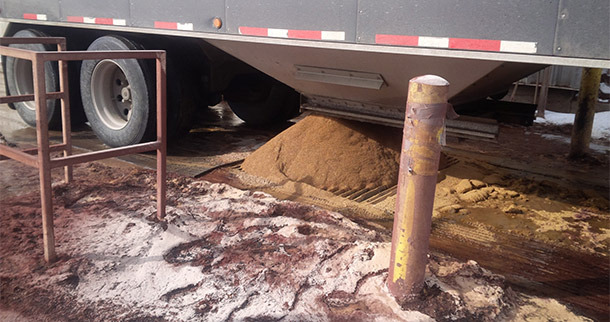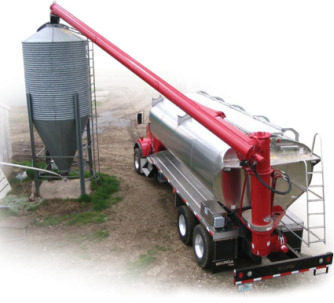The emergence of PEDV in North America triggered an awareness of the importance of feed and feed ingredients as potential disease transmission pathways. In addition to the concerns associated with ingredients of porcine origin (i.e. spray dried, rendered, and hydrolysed products) (Davies, 2014), the potential for cross contamination with fecal matter along the feed supply chain became an important concern when addressing swine herd biosecurity. These concerns resulted in a National Pork Board sponsored risk assessment on ingredients of animal origin (Davies, 2014) and the development a biosecurity assessment tool for swine feed manufacturing and distribution (Snider, AASV 2015)


Bulk Ingredient Reception illustrating potential for fecal cross contamination.
Decreasing the probability that a novel infectious organism will enter a swine production facility requires an understanding of the potential disease transmission pathways that may exist for any facility. Many times, transmission pathways are complex and seem to be out of the direct control of both the swine producer and consulting veterinarian. These types of scenarios require a collaborative approach amongst many segments of the swine industry and understanding the complex nature of the pathway requires several types of subject matter expertise. The transmission of Porcine Epidemic Diarrhea Virus (PEDV) through the feed supply chain is an example of a complex disease transmission pathway that triggered swine feed industry stakeholders to collaborate in understanding and addressing the risk factors.
|
Farm delivery of complete feed using typical midwest USA feed |
Following the emergence of PEDV in the eastern Midwest region of the United States in May 2013 (Stevenson, 2013), many stakeholders in the North American industry began to speculate that fecally contaminated feed ingredients and complete feed could play a role as important transmission pathways for Porcine Epidemic Diarrhea Virus (PEDV). This speculation was fueled by early reports that there existed a high level of genetic similarity between Asian strains of the virus and those isolates originating from the North American outbreak (Huang, 2013). The United States Department of Agriculture’s ‘Entry Assessment for Exotic Viral Pathogens of Swine’ outlined the significant role that ingredients originating from Asia play in the feed supply chain of the United States (USDA, 2013). As the industry struggled to understand how the PEDV was spreading from farm to farm within the United States, many stakeholders concluded that the virus may have entered the United States from Asia in imported feed ingredients that had been fecally contaminated.
During the early months of the outbreak in the United States, several individual herd outbreak investigations outlined scenarios that strongly implicated contaminated feed as the likely transmission pathway for PEDV into the affected herds. A prominent example included the high number of swine breeding stock herds that were affected throughout the industry. Breeding stock herds are typically required to implement biosecurity programs that are intended to protect the health of their own herds and the herds of the customers they serve. As well, the effective implementation of these programs is regularly scrutinized by veterinary inspectors as a part of the normal operation for breeding stock production. Finally, these herds are located in remote locations and are often ‘closed’ herds that produce their own replacement stock. In spite of these types of measures and intense scrutiny during the PEDV outbreak period, several of these types of herds were infected with the PEDV.
The emergence of PEDV in Canada, in January 2014, and the subsequent epidemiological investigation (O’Sullivan 2015) have played an important role in convincing many within the industry that ingredients of porcine origin, specifically spray dried plasma products, should be an important consideration when addressing how to manage the biosecurity risks associated with feed ingredients. Field research completed in the upper Midwest region of the United States suggested that feed could play a role as a fomite (Dee, 2014).
Requests from the swine industry to the University of Minnesota’s College of Veterinary Medicine’s Department of Population Medicine Swine faculty for assistance in assessing the biosecurity of the feed supply chain resulted in the development of a systematic framework to help veterinarians and swine producers systematically assess the biosecurity of their feed supply chain (Snider, AASV 2015).




